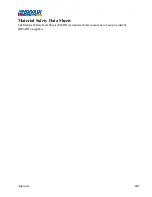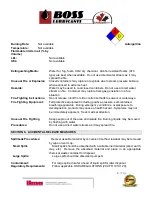
Product name: DOWFROST
™
Heat Transfer Fluid
Issue Date:
01/23/2015
Page 4 of 11
Methods and materials for containment and cleaning up:
Small spills: Absorb with materials such
as: Cat litter. Sawdust. Vermiculite. Zorb-all®. Collect in suitable and properly labeled containers.
Large spills: Dike area to contain spill. Recover spilled material if possible. See Section 13, Disposal
Considerations, for additional information.
7. HANDLING AND STORAGE
Precautions for safe handling:
No special precautions required. Keep container closed. See
Section 8, EXPOSURE CONTROLS AND PERSONAL PROTECTION.
Spills of these organic materials on hot fibrous insulations may lead to lowering of the autoignition
temperatures possibly resulting in spontaneous combustion.
Conditions for safe storage:
Do not store in: Galvanized steel. Opened or unlabeled containers.
Store in original unopened container. See Section 10 for more specific information. Additional storage
and handling information on this product may be obtained by calling your sales or customer service
contact.
8. EXPOSURE CONTROLS/PERSONAL PROTECTION
Control parameters
Exposure limits are listed below, if they exist.
Component
Regulation
Type of listing
Value/Notation
Propylene glycol
US WEEL
TWA
10 mg/m3
CA ON OEL
TWAEV Total
155 mg/m3 50 ppm
CA ON OEL
TWAEV
10 mg/m3
CA ON OEL
TWA
155 mg/m3 50 ppm
CA ON OEL
TWA
10 mg/m3
Consult local authorities for recommended exposure limits.
Exposure controls
Engineering controls:
Use local exhaust ventilation, or other engineering controls to maintain
airborne levels below exposure limit requirements or guidelines. If there are no applicable exposure
limit requirements or guidelines, general ventilation should be sufficient for most operations. Local
exhaust ventilation may be necessary for some operations.
Individual protection measures
Eye/face protection:
Use safety glasses (with side shields).
Skin protection
Hand protection:
Use gloves chemically resistant to this material when prolonged or
frequently repeated contact could occur. Examples of preferred glove barrier
materials include: Butyl rubber. Natural rubber (“latex”). Neoprene. Nitrile/butadiene
rubber (“nitrile” or “NBR”). Polyethylene. Ethyl vinyl alcohol laminate (“EVAL”).
Polyvinyl alcohol (“PVA”). Polyvinyl chloride (“PVC” or “vinyl”). NOTICE: The
selection of a specific glove for a particular application and duration of use in a
workplace should also take into account all relevant workplace factors such as, but
not limited to: Other chemicals which may be handled, physical requirements
(cut/puncture protection, dexterity, thermal protection), potential body reactions to
glove materials, as well as the instructions/specifications provided by the glove
supplier.
Other protection:
Wear clean, body-covering clothing.
Summary of Contents for 600 GTS Series
Page 2: ......
Page 47: ...Appendix 9 3 Electrical Schematics Figure 56 600 GTS sub 40 Electrical Schematic...
Page 48: ...Appendix 9 4 Figure 57 600 GTS Electrical Schematic...
Page 49: ...Appendix 9 5 Figure 58 HR2250 Electrical Schematic...
Page 50: ...Appendix 9 6 Figure 59 Trailer Wiring Schematic...








































